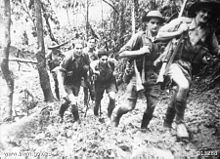- Damien Parer
-
Damien Parer 
Born 1 August 1912
Malvern, VictoriaDied 17 September 1944
Peleliu, PalauOccupation Australian cameraman and award-winning war cinematographer Spouse Elizabeth Marie Cotter Children Damien Parer Damien Peter Parer (1 August 1912 – 17 September 1944) was an Australian war photographer. He became famous for his war photography of the Second World War, and was killed by Japanese machinegun fire at Peleliu, Palau. He married Elizabeth Marie Cotter on 23 March 1944, and his son, producer Damien Parer, was born after his father had died. He was also the uncle of Australian politician Warwick Parer and film-maker David Parer. He was cinematographer for Australia's first Oscar winning film, Kokoda Front Line, an edition of the weekly newsreel, Cinesound Review which was produced by Ken Hall.
Contents
Early life
Damien Parer was born at Malvern in Melbourne, the tenth child of Teresa and John Arthur Parer, a hotel manager on King Island, Tasmania. In 1923, he and his brother, Adrian, were sent as boarders to St Stanislaus' College in Bathurst and St Kevin's College, Melbourne,.[1] He joined the school's camera club, and decided that he wanted to be a photographer, rather than a priest. However, finding a job as a photographer in depression-era Australia proved difficult, and so he resumed his education at St Kevin's in east Melbourne. While at this school he won a prize in a photographic competition run by the Melbourne newspaper, the Argus, and used the money to buy a Graflex camera used by professionals.
Parer obtained an apprenticeship with Arthur Dickinson. He said later that he learnt most about photography from Dickinson and Max Dupain. He finished his apprenticeship in 1933 and, sometime later, obtained work with the director, Charles Chauvel, on the film Heritage, where he met and became friends with another up and coming filmmaker of the time, John Heyer.[2] At the conclusion of that film, and with the help of Chauvel, he obtained work in Sydney, and so moved there in 1935.
Career
By World War II, Parer was experienced at photography and motion pictures, and was appointed as official movie photographer to the Australian Imperial Force (AIF).
His first war footage was taken on HMAS Sydney after it had sunk the Italian cruiser Bartolomeo Colleoni. Soon after, he was aboard HMS Ladybird while it was bombarding the sea port of Bardia in Libya. His first experience at close quarters was during a troop advance at Derna.
Parer filmed in Greece and in Syria, covering the action from aircraft, the deck of a ship and on the ground with the infantry. After Syria he travelled to Tobruk in August 1941 before covering the fighting in the Western desert. By mid-1942 Parer was in New Guinea ready to cover the fighting against the Japanese. Together with war correspondent Osmar White, he undertook an arduous journey by schooner, launch and then on foot from Port Moresby to Wau via Yule Island, Terapo and Kudjiru, in order to document the efforts of the meager forces then fighting on the northern coast of Papua New Guinea.[3]
During this phase of the war, he filmed some of his most famous sequences, some at Salamaua and, most notably, those used in Kokoda Front Line. This documentary won its producer, Ken G. Hall, an Academy Award for documentary film-making. Parer was killed by Japanese gunfire while filming a United States Marine advance in Palau on the island of Peleliu.
See also
References
- ^ http://www.adb.online.anu.edu.au/biogs/A150658b.htm
- ^ McDonald (1994) p. 13
- ^ Osmar White "Green Armour", Penguin Books, Melbourne, Australia, 1992
Filmography
Damien Parer is credited for the following films:
- Men of Timor (1942)
- Moresby Under the Blitz (1942)
- Kokoda Front Line! (1942)
- Assault on Salamaua (1943)
- The Bismarck Convoy Smashed (1943)
Notes
References
- McDonald, Neil (1994) War cameraman: the story of Damien Parer, Port Melbourne, Lothian
- McDonald, Neil (2000) "Parer, Damien (1912-1944)" in Australian Dictionary of Biography
- Who's Who in Australian Military History: Damien Peter Parer, Australian War Memorial
External links
- More information from AWM
- Damien Parer (II) at the Internet Movie Database
- Damien Parer at the Australian War Memorial
- Nine MSN on Damien Parer
- Photographic reels at the National Library of Australia
- National Museum Australia has one of the Eyemo cameras used by Parer filming Kokoda Front Line! in its collection
Categories:- 1912 births
- 1944 deaths
- War photographers
- Photographers from Melbourne
- Australian documentary filmmakers
- War artists
- Australian photojournalists
- People educated at St Kevin's College, Melbourne
Wikimedia Foundation. 2010.

